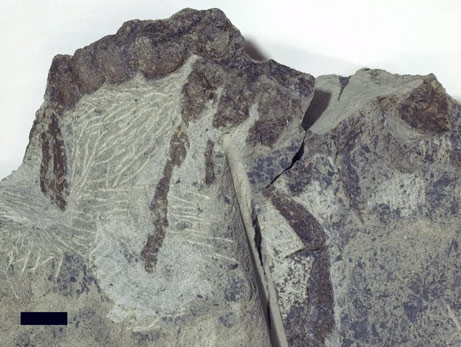![]()
![]()
Ancient Crayfish Fossils Unravel Evolution Mystery
February 8, 2008
New fossils of ancient crayfish and their branching burrows provide the oldest evidence of crayfish in the Southern Hemisphere, experts say.

The discovery in Australia of a 106-million-year-old crayfish fossil and
even older "trace fossils" of the animal's streamside burrows
help fill in a puzzling gap in the history of the small crustaceans.
The finding supports a theory that the evolution of crayfish has been strongly shaped by the drift of Earth's continents, researchers say.
Crayfish are the freshwater cousins of marine lobsters. Hundreds of known species are divided into two distinct groups, one in the Northern Hemisphere and the other in the Southern Hemisphere.
"It's been a mystery how and when they split into these groups," said Anthony Martin of Emory University in Atlanta, Georgia, who led the fossil discovery team.
Contributing to the mystery was an absence of any very old crayfish fossils from the Southern Hemisphere.
Fossils have shown that crayfish were present in the Northern Hemisphere at least 150 million years ago. But for over a century biologists have been puzzled by the lack of any comparably old fossils from the southern continents.
"There was a 60- to 70-million-year gap in the fossil record," Martin said. "Now we're a lot closer to the origin point of the Southern Hemisphere crayfish."
The study by Martin's team is set to appear in a forthcoming edition of the journal Gondwana Research.
Evolution and Continental Drift
Scientists have long debated whether today's northern and southern crayfish all descend from a common ancestor that was already adapted to fresh water, or if the two groups evolved the freshwater adaptation independently of one another.
A shared freshwater ancestor would require that crayfish first evolved very early, when all of Earth's continents were united in a single landmass called Pangaea.
This theory has been supported by genetic studies that suggest the two crayfish
groups diverged around the same time that Pangaea split into northern and
southern "supercontinents" about 185 million years ago.
Ancestors of today's crayfish would then have ridden the slowly drifting landmasses north and south, eventually branching into numerous species as the continents continued to divide.
However, to show conclusively that the ancestors of northern and southern crayfish once lived on a united Pangaea, even older fossils will be needed.
Carrie Schweitzer is a geologist at Kent State University in Ohio.
She said the alternative explanation that freshwater crayfish evolved independently in the northern and southern continents cannot yet be discarded.
For drifting supercontinents to explain the origin of the different families, she said, "crayfish would have had to have invaded freshwater [habitats] really early and become widespread by the time Pangaea started to split. So far, we really don't have evidence of that."
Early in Australia
The new fossils also provide clues about the origin of the numerous crayfish species found in Australia today.
The fossil dates are consistent with results of recent genetic studies, which suggest that many new crayfish species began to appear in what is now Australia about 134 million years ago.
At that time the continents of Australia, South America, and Antarctica were just starting to break off from the southern supercontinent of Gondwana.
Just as the breakup of Pangaea may have forever divided the two main crayfish lineages, Martin believes, the later splitting of Gondwana may have resulted in a surge in crayfish diversity.
The early crayfish apparently thrived in a near-polar environment in southeastern Australia, and must have been adapted to cold water temperatures and freezing winters just like some modern crayfish species.
"These crayfish were burrowing much like modern ones in the same area today, showing that their behaviors haven't changed that much in more than 100 million years," Martin said.